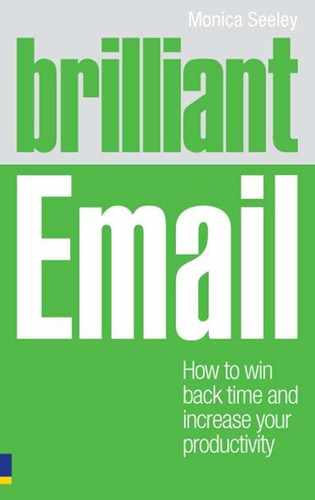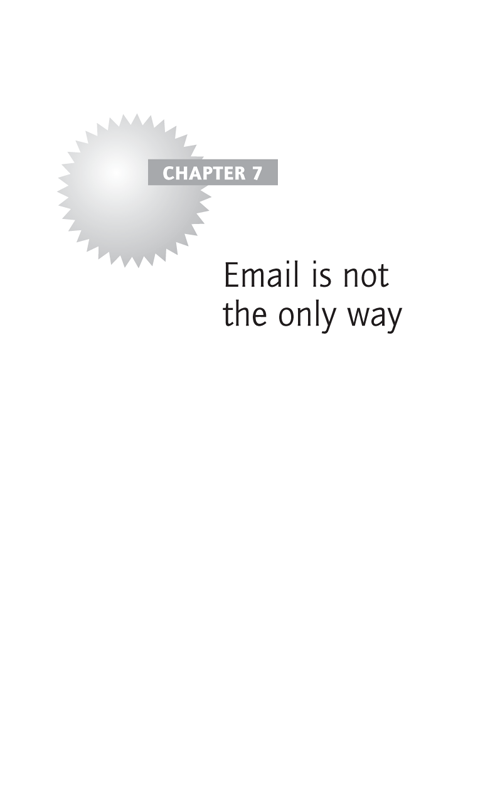Peter Drucker
Email has some inherent strengths and weaknesses, some of which have existed since its invention in the early 1970s. Unfortunately, as is born witness by some of the more prominent email media disasters, email’s strengths can also become its weaknesses. This chapter covers:
- a brief history of email and its evolution as a channel of communications
- the importance of remembering that email is only one of many choices of communications media available to you
- how to work out which communications channel to use and when.
In order to capitalise on email’s strengths and mitigate its inherent weaknesses, it helps to compare the merits of its use against those of other communications channels such as talking. The well tried and trusted ‘media richness’ model (see page 98) provides a simple and useful basis for making this evaluation. It gives you a sound foundation on which better decisions can be made about how to use email to maximum advantage.
Take the example of ‘Ketchupgate’, where a PA in a prominent law firm spilt ketchup on a senior partner’s white linen suit. He emailed asking her for the £4 cleaning cost. She was absent at the time he sent it as her mother had been taken ill and died. On her return she was sufficiently miffed at the email and circulated it to her friends, who forwarded it to their friends. The story made the national press and broadcast media. The partner resigned and the law firm’s reputation was tarnished. See www.brilliant-email.com for more such examples of email media disasters.
How has email evolved?
Email was designed as a messaging tool, for sending clear, unequivocal, unemotional and preferably short messages. That has not changed in the 30 years it has been around, but what has changed is its accessibility. It is no longer confined to a few boffins or geeks with large computers. Today everyone, everywhere, can use emails at any time to send and exchange information anywhere, from the smallest to largest computer. You don’t need permission to send an email as you did in the early days of its use in business. Email software has become more and more sophisticated and feature-rich. However, whatever email software you use (from Notes to Outlook to Googlemail), its core purpose is to be a simple messaging system. This is something most of us forget as we hit ‘Send’ without giving a thought to the alternatives available to us.
Speed versus depth and breadth of communications
Email is easy, always on and takes little effort. Other options may require more effort and time. With email you get a very blinkered dialogue, whereas even a short conversation often reveals information about other seemingly unrelated, yet often important, topics (a cursory reference to a job vacancy, a way someone else handled a difficult customer, a new competitor, the opportunity for a new story, etc.)
With one client we had an email-free afternoon as part of a major internal campaign to improve efficiency through better use of email. One senior director openly spoke about how, after walking and talking to several colleagues, he had a far greater insight into what people were doing, their workload and the depth and breadth of activities with which his department was involved.
![]()
Next time you are about to send an email to someone in your building, stop. Go and talk to them. Note all the other information you glean, not just by talking to that individual but from looking around the office and the corridor conversations that happen en-route. Then make an honest judgement about how much more you have learnt and the value it added to how you do your job and run your team/operation.
Most people quite rightly think that email is quicker and that using the phone can take much longer. For instance, suppose you wanted the opinion of five key colleagues about a short proposal or document. Using email, this might take a maximum of 15 minutes (five to send the email and ten to scan their responses). By phone the minimum is around 30 to 45 minutes – five minutes per person and then at least five minutes to assimilate their comments.
If speed equals productivity, then email wins hands down. But is this the correct way to make a judgement about communications?
Minimising misunderstandings and communicating more accurately
A framework called ‘media richness’ was developed by Daft and Lengel. The aim was to categorise different communications channels by their ability to allow the sender to communicate information accurately, without it being misunderstood by the recipient. In an age where the norm is email or text messaging, this concept can help you decide when to use alternatives to email.
Based on this, an overview of the current array of ways to communicate is shown in Figure 7.1.
The conclusion was that the more surrounding body language and gestures that accompany a message, the richer and so more easily understood it will be. Therefore, the richer the communication medium, the better it is for conveying complex and emotive messages, especially those easily open to differing interpretations, such as reviewing performance, a lost sale, negotiating a deal.
Using a ‘rich’ communication medium like a face-to-face meeting allows any misunderstandings or misperceptions to be quickly corrected and the communications re-aligned. A simpler or ‘lean’ medium like text messaging and email has no associated context. Once the message has been received and misinterpreted it can take time to re-align understandings and retrieve a situation.
Additionally, the longer the gap between the misunderstanding and the opportunity to rectify it, the harder it can become to retrieve the situation because the incorrect picture will have become established in the recipient’s mind.
Drawing on the ‘media richness’ framework, here are the three rules of thumb for making decisions and choosing the optimum communications channel:
- How easy is it for your message to be misunderstood?
- If your message is misunderstood, how quickly can you get the interaction back on the right track?
- How much does it matter to you (and your business) if the interaction is misunderstood?
Media richness at work – justifying the choice
A simple medium like email and text messaging is excellent for factual non-emotive messages. These leave no scope for misunderstanding and, even if there were any, there would be no extra cost to you and your business. Ideally you should not sack employees by email, let alone by text message, as this is a very emotive matter.
However, consider this example: in 2009 Hyde Park Corner Autocentre sacked its entire staff by email. Was it easy for the message to be misunderstood? No. Did it matter to the business? No. The company had just ceased trading. Employees were outraged at being sacked by email, feeling it was the wrong medium. The managing director defended his choice of medium by saying ‘I wanted to tell everybody at the same time and that [email] was the best thing to do and follow it up with a phone call.’ For the sender it worked and the negative consequences were zero. Hence it was probably the most cost-effective choice of media.
While I don’t endorse the use of email in such circumstances, do not be put off by headlines like ‘Payout for worker sacked by email’ and ‘Teacher sacked by email’. The case is generally about the cause of and grounds for dismissal rather than the manner.
Nonetheless, where there is scope for misunderstanding, even if the message seems uncontroversial, look for a richer medium as there will be a high cost if it all goes pear-shaped.
Consider this example: you want to take a day’s leave. It’s the busiest part of the month but your reason is important to you (for example, a friend’s wedding). An email message could be misinterpreted as ‘I don’t care’ and the response could be no. There would then be little scope for renegotiating. The optimum channel here would be a conversation, as then you can explain yourself and sell your case better.
Email does have many considerable advantages over other media in the communications spectrum, in particular talking. However, these advantages can quickly become disadvantages if email is used irresponsibly, as the next chapter will demonstrate.
- Email may be one of the fastest ways to communicate, but in contrast to a conventional face-to-face conversation, email provides a very narrow blinkered dialogue. This means there can be considerable scope for misunderstandings, which can be costly. Other important information can be missed.
- Looking at the ‘richness’ of the media allows you to evaluate at the broadest level the best choice of communication channels for your message in a given set of circumstances.
- Before defaulting to email ask yourself:
– Is speed the only consideration?
– What might be the cost to me (or my business) if there is a major misunderstanding as a result of the recipient not seeing the full picture?
– Is there a better way(s) to communicate my message that will limit the risk of any major misunderstanding?


